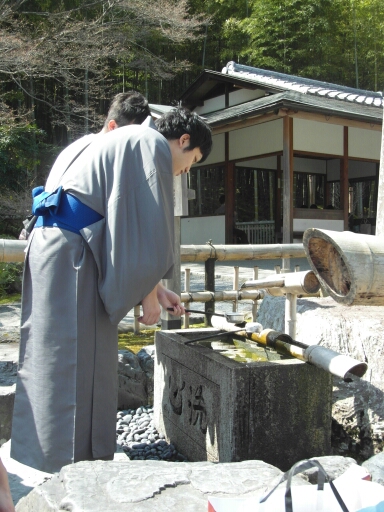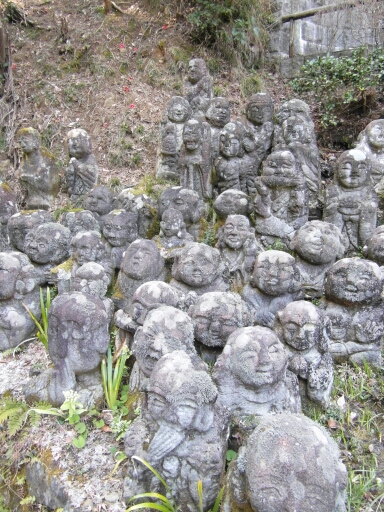I left my hostel in Osaka to the first of many days of rain in Japan with a highly unusual spring in my step, because as I was leaving the owner insisted on giving me an umbrella. Not lending, giving. That’s how nice people are here.
The train from Osaka to Kyoto is ridiculously easy, it may as well be part of the same city. I think if you pay for the bullet train it only takes about 10 minutes, but the regular trains still only take 40. Unfortunately getting here that early wasn’t especially helpful as I couldn’t check into my room until 3, and as my cheap rubbish shoes were leaking the spring in my step had turned into more of a squelch.
Kyoto is known for its temples and shrines – the city famously has over 2000 of them, but they aren’t the best thing to go for in the pouring rain, so I spent much of my time popping in and out of museums instead. Very close to my hostel were the National Museum of Modern Art, with a very bizarre exhibition of Japanese haute couture, mostly featuring clothes that looked like they would struggle to fit on a normally proportioned human being, and the Kyoto Museum of Traditional Crafts, which is really rather good for a free museum and gives a great overview of various different handicraft traditions which, if you’re anything like me, will make you extremely eager to take up Japanese embroidery and dye techniques until you come to your senses. My favourite though was the tiny but wonderfully obsessive Kaleidoscope Museum, which i found hidden away downtown behind the Museum of Kyoto, where I was shown around by an enthusiastic woman who spoke no English but insisted on showing me how to operate at least 50 different kaleidoscopes, until I emerged clutching a DIY kit and fired up with a desire to make kaleidoscopes for everyone I know. (Don’t worry, I will probably abandon that idea as well, in case you know me and are worried about faking a grateful response to something so pointless)
In case you’re after something more modern, there’s also the option of the International Manga Museum. In case you’re unaware, manga are Japanese comic books, except about 10 times as popular as western graphic novels and apparently something that there’s no need to grow out of as you’ll regularly see middle aged business men engrossed in manga novels on the train. As well as the usual heroes and sci fi and high school romance stories, manga branches out into political satire and historical fiction, and even non fiction books like business manuals and cook books!
There was a temporary exhibition on at the time from a fashion brand who used manga novels as their influence (they were very clear in their blurb that these were Not costumes, but… not sure I can tell)
I can’t decide whether this is more or less weird than what I saw people wearing normally. Either teenagers go on a lot of school trips on the weekend, or its just a trend to wear school uniforms everywhere.
OK, this is more weird than average Japanese fashion. Not by very much though.
There’s a small exhibit on the history of manga, but really the rest of the museum is just an excuse for a huge library where people can come and pick books off the shelves and read to their heart’s content.
(No photos in most of the museum for copyright issues, but I couldn’t resist taking this one of the floor in the children’s library, because I would have killed for a floor like that when I was a kid)
There a mini section downstairs of translated manga, both foreign to Japanese and vice versa, so I joined the crowd and sat down with the first issue of Naruto in English, next to a guy reading Watchmen in Japanese.
Then I promptly got mocked by the boyfriend that evening because ‘Naruto is bad and you should feel bad’. Well excuse me King of the Geeks, not all of us have an inexhaustible knowledge of these matters.
Having satisfied modern Japan urges, I wanted to spot a geiko or maiko in their native Kyoto (local terms for geisha and geisha apprentices), but this was easier said than done. There are a lot of people wandering round in kimonos, but more often than not these are going to be tourists who have paid to be dressed up for the day.
The real geisha are rarely seen on the streets unless they are on their way to or from an appointment and aren’t going to stand around for people to take photos of them.
A real maiko? Possibly? I’m not sure.
The only time I was mostly convinced was when I saw a very elegant middle aged woman in the Gion district step from a front door straight into a waiting taxi. Too fast for me to take a photo, but it left me with a feeling that I’d been lucky enough to see a beautiful rare animal in its natural habitat. If you want to see them properly and don’t have the cash to pay for private entertainment (and no, that doesn’t mean sex), there are geisha dances performed in Gion. Of course, I had not planned this in advance so I was annoyed to find that the dances don’t start till April, two days after I left Kyoto. Damn it. I thought the year round alternative offering an introduction to various Japanese arts looked a bit cheesy and watered down, so instead I went for a completely different night and bought a ticket to Gear, a futuristic non verbal performance involving magic and breakdancing and juggling and alarmingly, safely goggles.
(ended up not needing them since my seat was far enough away from the enormous fan that goes off halfway through) Definitely recommended, especially if you can smile sweetly and get the half price ticket at the end of the row.
Next day the weather finally cleared up so I decided to see a little temple I’d seen on one of the first travel blogs I ever read, which was one of the attractions in the Arashiyama area. The guide book recommends two temples at this site, Tenryu-ji and Gio-ji. I visited both because they were on the way, and they were OK, but honestly I was left with the usual feeling of ‘what was so special about that one?’
Lucky frog pond and sacred water at Tenryu-ji
The bamboo groove behind Tenryu-ji. I appear to have caught someone mid-gleeful skip.
A lot of moss at Gio-ji
The one I was aiming for, Otagi Nenbutsu-ji, is beyond the edge of the map and therefore doesn’t exist according to lonely planet, but can be reached by carrying on up the road from Adashino Nenbutsu-ji and taking the right fork after the giant torii gate. When you get there you’ll be greeted by a thousand mini statues of Buddhist disciples, all donated by temple visitors and all different.
And for the most part, all completely nuts. Along with sunglasses, a walkman and a very proud cat owner, I came across a monk playing tennis, one eating corn on the cob and one mid head stand. If you’re in the area, definitely go and find your favourite!


















Love love love kaleidoscopes!!! Looked for one in vain when we visited E’burgh recently and went to the camera obscura museum which is full of optical illusions and gadgets.
As always Hannah, your blog makes for great reading. And I just love to see the photos, it gives a real sense of being involved in your journey. Japan looks so lovely, I was surprised to see so much green – I’ve obviously been looking at too many Japanese films with Clem where everything seems so bleak! Looking forward to your next posting. x